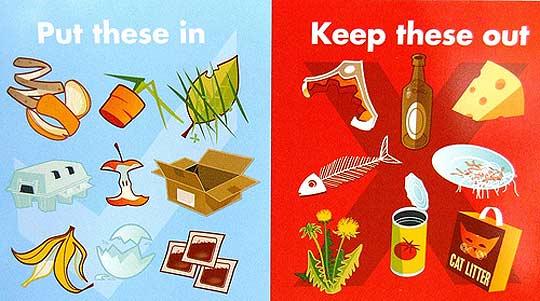Composting is the natural process of decomposition and recycling of organic material into a humus-rich soil amendment. Because the organic materials (kitchen and yard waste) are being recycled, this reduces the amount of waste going into landfills, which is highly beneficial for the environment. When compost is used in the landscape, it improves soil structure, texture and aeration and increases its water holding capacity. It loosens clay soils and helps sandy soils retain water. Adding compost to soils promotes soil fertility and stimulates healthy root development in plants. Because of the excess leaf litter, fall is the perfect time to build a compost pile, because compost is a mix of green and brown materials.
Essential Ingredients for Amazing Compost –
- Brown Materials – This includes items which are high in Carbon such as wood chips, straw, sawdust, dried leaves and woody plant materials (chopped finely).
- Green Materials – This includes items which are high in Nitrogen such as grass clippings, fruit and veggie scraps, coffee grounds, tea bags, and manure.
- Water – Moisture is essential for the survival of organisms which break down the brown and green materials into soil. Too much water will suffocate organisms and too little will decrease the amount of organisms which can survive and thus will slow the decomposition process. The optimum moisture content is 45-50%, which is damp to the touch but not soaking.

Building the Pile –
- Balance – A balance of wet green materials and dry brown materials are essential for compost piles in order to attract microorganisms that will generate heat. Heat helps to break down the ingredients and converts them into nutrient rich humus as well as killing pathogens and weed seeds. Using only brown materials will slow the decomposition process greatly because alone they attract few microorganisms and generate very little heat. Using only green materials will generate an unpleasant odor.
- Slow Composting – Slow composting involves adding brown and green materials in no significant order with water and letting the pile sit to allow nature to take its course. This method is much simpler to accomplish, however decomposition takes much longer.
- Quick Composting – This method allows decomposition to occur much faster and is accomplished by layering green and brown materials in equal amounts. Add water with each layer and mix once a week to distribute all the materials.
Container/No Container –
- No Container – A container is not necessary for composting, however the minimum size of the pile should be three feet high and wide. Smaller sizes will not allow enough heat to be produced for decomposing.
- Containers – Homemade or purchased containers work equally well for composting. Make sure your bin has holes for aeration and enough room for mixing the compost.
Items to Avoid –
- Coal and Charcoal – Both have excessive amounts of sulfur and iron, which in such high amounts are toxic to plants.
- Colored Paper – Most colored inks are toxic to plants.
- Diseased Plants – Some diseases are not eliminated by the temperatures created by the compost pile and can infect plants when used in the landscape.
- Fish, Cheese, and Meat – These items attract flies and are susceptible to diseases that are harmful to humans.
- Dog and Cat Litter – The excrement from these animals carries a number of diseases that are harmful to humans.
- Toxic Chemicals – Insecticides, pesticides and poisons kill beneficial organisms needed for decomposition and can be harmful to humans as well as plants in the landscape.

